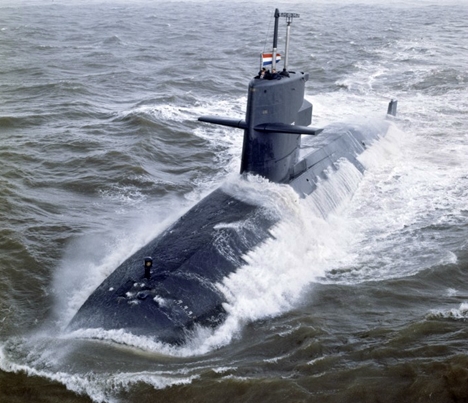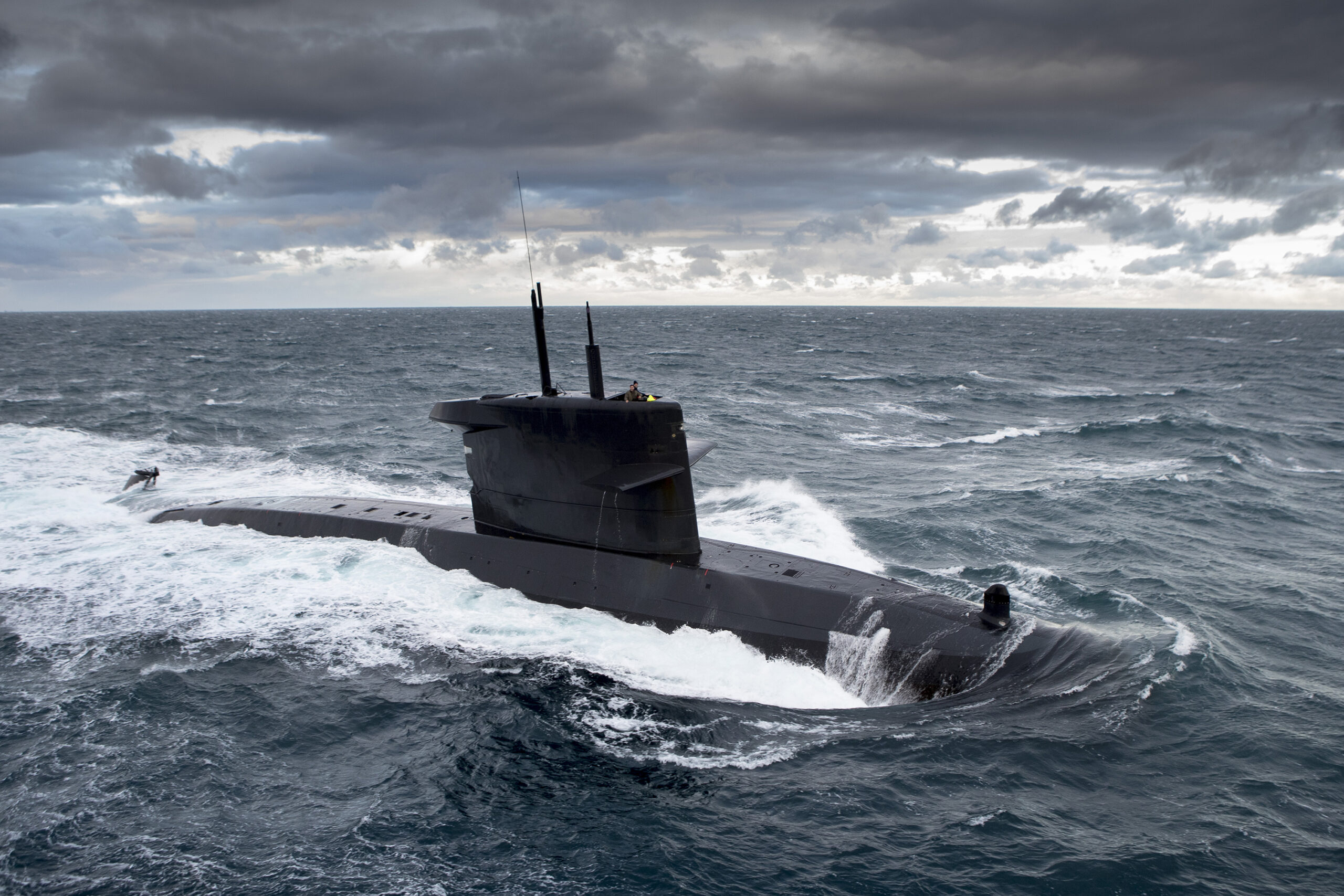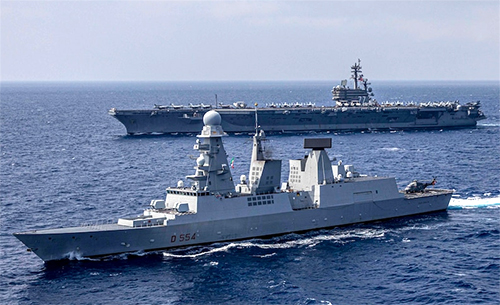Finally: drones can hunt submarines, ships can communicate with submerged submarines
Without water there would be no life, and worse, no ships. But water is not always our friend: even gigantic submarines are very difficult to find, and communication with submarines is almost impossible. The Canadian company Geospectrum Technologies has come up with a solution to these problems.
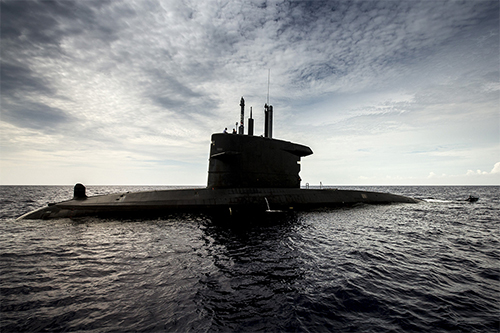
HNLMS Zeeleeuw, filephoto. (Photo: Dutch MoD)
A NATO anti-submarine warfare frigate in the Atlantic Ocean is ordered to hunt for a nuclear submarine that, based on observations by various sensors, is suspected to be approaching a position within range of the frigate rapidly. The frigate is designed to combat submarines: the latest sonar (hull mounted sonar) is mounted under the bow and the low-frequency sonar that can be towed behind the ship allows submarines to be detected from a great distance. In addition, the ship has an anti-submarine warfare helicopter and two unmanned surface vehicles (USVs). These USVs are equipped with the Towed Reelable Active / Passive Sonar (TRAPS): a system using passive and active sonar.
“A single ship is unlikely to survive a confrontation with a submarine,” says Sean Kelly, a former anti-submarine warfare officer in the Canadian Navy who is now working at Geospectrum. “But if a group of ships takes on a submarine, the submarine is at a disadvantage.”
“By having a helicopter and USVs search for that specific submarine, hereby supplementing the frigate’s on board capabilities, we are actually creating our own task group. A great tactical advantage, and useful in times when Western navies are confronted with a shrinking fleet.”
Both the USVs and the helicopter are deployed at a great distance from the ship. “A frigate’s own sonars should actually stay out of the submarine’s range,” says Kelly.
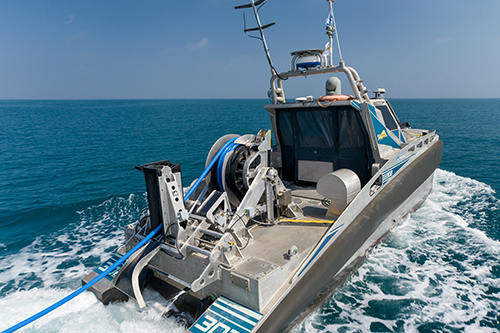
A Seagull USV with TRAPS. (Photo: Elbit)
Our frigate is advancing towards the position where the hunt for the hostile submarine can begin. The USVs and helicopter are prepared for deployment. “Let’s say that the sonar ranges that day are 30 nautical miles,” Kelly continues. The ship can therefore detect submarines up to a maximum range of 30 miles with its own sonar, but so can the USV. “So if you send your USV 30 miles forward and the helicopter too, you can search from a greater distance. Now you can increase your sonar range to 60 nautical miles or more in one go. ”
Operating as an ASW picket, the unmanned vessel lowers the low-frequency active sonar into the water and starts to ping loudly. The sound signal ripples through the cold Atlantic Ocean and bounces off objects, but not just back to the USV. Kelly: “You ping in one location, you receive in another location.” In this case the echoes reach the sonar that is towed behind the frigate and the received signals are processed by the software on board the frigate.
“In waters such as the Atlantic, the Pacific or the South China Sea, I want a sonar with the lowest possible frequency,” says Kelly, “because that gives you enormous range. But not all ASW-operations take place in such deep waters. ”
The position of the enemy submarine in our story turns out to be more towards coastal waters. Our frigate recovers the USVs and helicopter and sails to the newly specified position. On board a plan is made how the submarine can be located in shallow waters. “Low-frequency sonars are less effective in coastal waters,” says Kelly. “Here we need medium frequency sonar.”
Almost all naval sonars operate on one single frequency. This is not the case with TRAPS though. Kelly: “The USVs have been recovered and we only need to replace a small part so we can deploy a medium frequency sonar. Half an hour later the USV is back at sea and the USV can search for the submarine again. If you are not able to change that frequency, you will lose the submarine in no time. If you can adapt quickly, you have a huge tactical advantage. ”
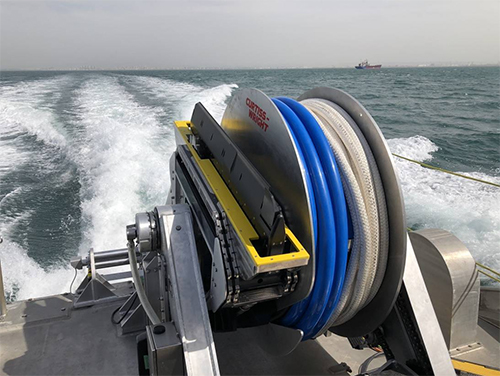
TRAPS with passive and active sonars visable. The black transmitter part has to be swapped if an other frequency is needed. (Photo: Geospectrum)
TRAPS
The name of the TRAPS system has previously been mentioned in articles on Marineschepen.nl and Naviesworldwide.com. Specifically in the article about the Seagull unmanned surface vessel, which was developed by Elbit Systems and is being built in the Netherlands by De Haas Maassluis.
As we have just seen in the example, an important addition to that specific USV is TRAPS: a sonar set consisting of a long array fitted with hydrophones for listening, and the active part being formed by a transmitter.
TRAPS is the flagship product of Geospectrum, which focuses on underwater acoustics for naval and civilian applications. The system has been under development for some time, and has recently been installed on various ships of the Canadian Navy. TRAPS can also be used as an add-on sonar for patrol ships, for example. However, in this article we will focus on the version intended for USVs. The latter version is extraordinary, as currently there is, according to Geospectrum, no sonar for unmanned ships that is operational on this level.
What TRAPS exactly will look like in practice depends entirely on the requirements of the customer. “We have hundreds of options,” says Kelly. “Every navy operates in slightly different circumstances, so there is no sonar that works for all of them. And during operations conditions often change for naval vessels as well. Therefore, TRAPS is also highly modular and can therefore be adapted to the ongoing situation.”
Another advantage of the system being modular is the fact that you do not have to return to port when there is a malfunction, but can easily replace the broken part.
The active sonar can ping on frequencies between 2 kHz and 10 kHz, simply by changing the transmitting part. Hence TRAPS is suitable for bi-static operations (transmitting and receiving at different locations). Complex waveforms are also be accommodated, Kelly assures. With passive sonar, it is the length of the sonar array that determines the lowest frequency (and the lower the frequency, the greater the range that can be achieved).

Changes to the design of the Belgian and Dutch ASW frigates have affected the sizes of the USVs.
Integrating TRAPS with small USVs
This is nice and all but is it also useful for the navies of the Netherlands and Belgium? After all, about a year ago, a design change was approved which led to a reduction of the space for accommodating unmanned vessels on board the future Dutch and Belgian ASW frigates. Instead of 12m USVs, these future vessels will have a maximum length of 7 meters.
This means the standard version of the Seagull can no longer be facilitated on these ships. A smaller version will have reduced range and cannot be used in certain sea states. How does this affect TRAPS?
TRAPS is not made for one specific USV size. “When we are confronted with less space, we will make the passive part of TRAPS smaller. This means that if the vessel gets smaller, the passive capabilities will be reduced,” Kelly explains. However, “we consider the active part the most important, we will never change that.”
Does all this mean we can breathe a sigh of relief? No. “A 7 meter USV will be very difficult,” Kelly notes. “We will definitely look into it, but the weight is the problem. Not so much the vessel’s length. Coincidentally, an other navy recently decided to extend the length of their USVs in connection with TRAPS, ” Kelly adds hopefully.
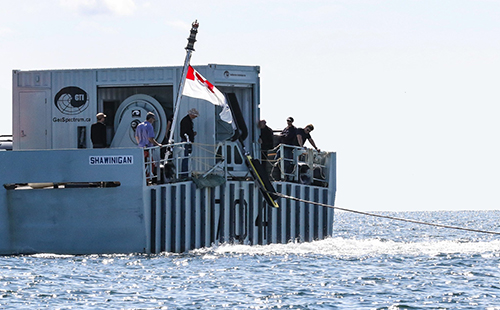
Canadian Coastal Defense Vessel HMCS Shawinigan (Kingston class) operates with a containerized TRAPS version. (Photo: Geospectrum)
Sales
TRAPS has already been sold to the Canadian Navy. And recently a navy in “Asia” procured several TRAPS systems. “Unfortunately, we cannot say which navy it is,” Kelly says. “We are also negotiating with a navy in the Middle East, and we expect more sales in the near future.”
Communicating with submarines
While TRAPS is meant to detect submarines, LRAM has been developed by Geospectrum to communicate with submerged submarines.
Underwater communication is extremely difficult due to the difficult properties of seawater. How can a submarine receive messages from its headquarters when it is engaged in a covert operation thousands of miles away? Impossible if the boat is operating in very deep waters. More and more submarines do have satellite communication. However, to use this the boat has to go to periscope depth, and at that moment there is a higher chance of detection.
In the past submarines used a so-called postbox procedure: a maritime patrol aircraft flew from, for example, Keflavik (Iceland) to a predetermined position in the Norwegian Sea with the NATO-submarine setting up its antenna, after which both could transmit messages at short range. However as a result Russian units were able to track the aircraft and detect the submarine.
Yet another option was Extremely Low Frequency (ELF) communications. During the Cold War, a number of gigantic cell towers in the US, Great Britain and Norway were emitting at extremely low frequencies using tremendous power. Messages could thus be sent to submerged submarines operating far away from port, but the cost of maintaining such a huge broadcast station was enormous. Therefore, they are no longer in use.
Geospectrum has now developed a solution: the Long Range Acoustic Modem, or LRAM. Any transmitter can be linked to LRAM, for instance TRAPS for shorter ranges, or the Very Low Frequency C-BASS system, another Geospectrum product, in order to achieve long range communications.
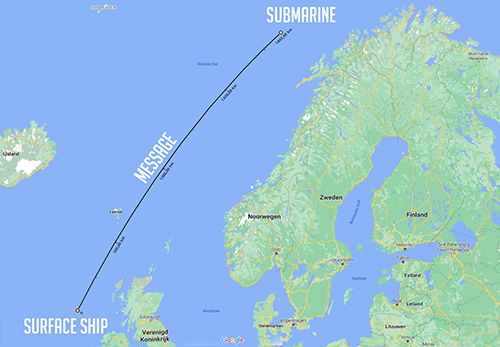
With LRAM and C-BASS a ship can send a message to a submerged submarine operating 1,000 nautical miles (1,852 km) away. (Photo: Google Maps, text added by Naviesworldwide.com)
Long range
Talking about long range we mean really long range: 1,000 nautical miles. “But it can also be done at an extremely short distance: 10 yards,” Sean Kelly says. “LRAM enables communications with divers, unmanned underwater vehicles and submarines.”
Thanks to LRAM it is possible to send messages to submarines from shore, but also by ships. This means a commander of a task group which includes a submarine can also send messages. “If a submarine is part of a task group, that specific submarine still mainly operates on its own and receives messages perhaps once a day or every few days,” Kelly says. “However there can be significant change in a day or in a few hours.”
An LRAM broadcast using C-BASS will stand out, however the great distances being covered in all directions has the advantage that this is of little use to an opponent: the area with a radius of 1000 nautical miles is simply too large to search for a submarine.
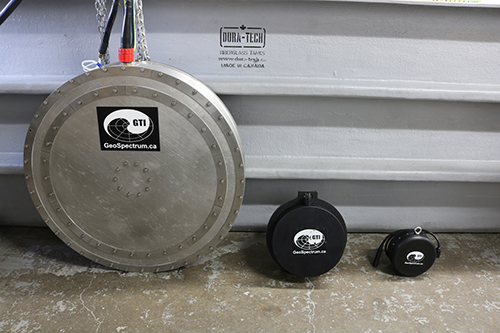
C-BASS family. (Photo: Geospectrum)
C-BASS
To be able to communicate over such great distances, an underwater transducer is needed that works at very low frequency and has a lot of power. “When we started the project, there was one similar system,” Sean Kelly recalls. “However that system had the size of a large delivery van and weighed 3 tons. Totally unsuitable for naval ships.”
“We promised to build a small system that could transmit at 40 Hz, which is extremely low, with a power of 200 dB. Some experts said we couldn’t do it and said we could bring the system over once it was finished and they would explain why it didn’t work, ” Kelly says.
“So we started developing it and it became a device with a diameter of one meter, weighing 300 kg transmitting at 40 Hz. The power was more than 200 dB. We showed it to the previously mentioned experts and they immediately bought two. It is a breakthrough in underwater acoustics. ”
Then there were the at sea trials. They were a success, the small device could send and receive messages over a distance of 1,000 nautical miles.
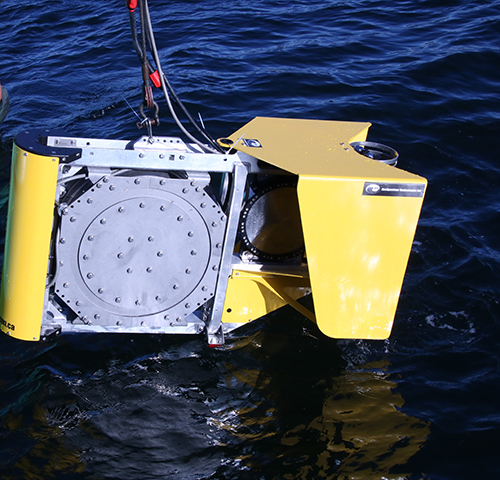
C-BASS transmitter in LRAM system put into the water by a ship. (Photo: Geospectrum)
Text messages
However, submarines still cannot stream videos; only very short text messages are possible. “It’s more like encoded Morse code,” Kelly explains. “We have 16,000 pre-programmed messages in the system, which the sender can choose from. There is also a method to create your own messages, but it is actually not designed for that. ”
So the bandwidth is limited, but still much more than that used during Cold War submarine broadcasting, Kelly says. “An ELF broadcast station costs billions of dollars, your radio frequency antennas have to be miles long. LRAM costs just a fraction, can be put on a ship, is highly mobile and has much more bandwidth.”
In addition, the system is designed to be reliable, because typically the sender does not get a return message from the submarine.
Unless the submarine is in distress. Kelly: “Some navies are also interested in LRAM from a safety perspective. A submarine that is in distress or lying on the seabed can then send a message about its status and its position. ”
The sea will remain a challenging environment for a long time. However, due to the latest advances in anti-submarine warfare using unmanned vessels and sub sea communication, things will really change under water.
This is a sponsored article. With a sponsored article, a client chooses the subject of the article. Geospectrum paid Marineschepen.nl to write this article on this topic, but Geospectrum had no influence on the journalistic content.

